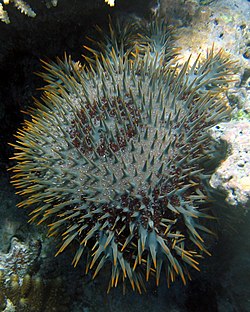Respuestas para la especialidad JA de Arrecifes de coral
Nivel de destreza
1
Año
2018
Version
31.12.2025
Autoridad de aprobación
División Norteamericana
1
Los arrecifes se forman en el agua de mar y son una acumulación de los restos de las partes duras de los animales, principalmente carbonato de calcio. Algunos arrecifes pueden tener más de 30 m de espesor. Algunos arrecifes se forman a partir de capas de ostras (u otras especies de moluscos) que crecen unas sobre otras, llamadas arrecifes de ostras. Algunos arrecifes están compuestos por capas de esqueletos de coral que crecen uno encima del otro, llamados arrecifes de coral.
2
2a
Los corales son animales.
2b
Corals are in the phylum Cnidaria (the C is silent - nigh dare ia). Some forms of Cnidaria are mobile and swim around like jellyfish, other types are sessile which means they are anchored to the substrate and do not move around. These are the corals that build coral reefs.
2c
Only the top layer of a reef is alive. As we will learn later, corals require sunlight to live so only those on top can survive.
2d
Hard corals are soft-bodied animals which secrete a hard calcium carbonate layer around them and have multiples of 8 tentacles used in feeding. These are the reef builders. Soft corals are soft bodied animals which secrete very little calcium carbonate so they are not hard, but can sway back and forth in the ocean currents. Soft corals have multiples 6 tentacles used in feeding.
3
Coral reefs are found between 30 degrees north and south of the equator.
They require:
- Warm water
- Shallow water (so that there is enough sunlight),
- Saltwater
4
4a
4b
4c
4d
5
Zooxanthellae are microscopic algae that live inside soft parts of corals. The different species of zooxanthellae give the corals their color (otherwise they would look white – the color of calcium carbonate). The calcium carbonate shell of the coral protects the delicate algae. The coral benefits by eating some of the sugar that the algae make using energy from the sun. This is a great example of symbiosis – both the coral and the algae benefit by living together.
6
6a
At night, the corals extend their soft tentacles out into the water to trap and collect food that is floating in the water. They use nematocytes which are microscopic harpoons loaded with venom to catch and stun their prey before eating it.
6b
Corals grow a garden of algae and eat sugars and other molecules produced by the garden of algae growing in their body (the zooxanthella). This is why corals can only grow in shallow water where there is enough sunlight for the zooxanthella to grow and do photosynthesis. It is also why only the top layer of a coral reef is alive. If another coral grows over top, the one below will die because its zooxanthella will not get any light and there won’t be food for the coral on the bottom.
6c
By filtering all the food particles out of the water (a above), the seawater around a reef is very clear.
7
Fungia sp. skeleton
Polyps of Eusmilia fastigiata
Pillar coral, Dendrogyra cylindricus
8
25% of the animals in oceans are found in reefs, although reefs account for only about 1% of the ocean surface area.
9
stars, jellyfish, anemones, sand dollars, sea cucumbers, and many more.
10
When conditions change (temperature, pH, light levels salinity, etc.) the corals dump out their colorful zooxanthella and become white (the color of their calcium carbonate shells); then they take in new zooxanthella with different characteristics that might thrive better than the previous zooxanthella. It’s just a "gamble" to try to survive better with a different genetic combination. For some corals, the gamble is lost and they die. For other’s the new Zooxanthella do make a difference and the remaining coral takes over the reef building on top of the old coral. Climate change is resulting in increased temperature in the coral reef areas and is causing a lot of bleaching. Too much bleaching can cause the reef to die because it simply can’t keep up.
11
Lionfish have venomous spines and frilly fins. They are native to the Indian and Pacific Oceans. They were dumped into the Atlantic Ocean by pet owners that did not want to keep them anymore. They thrive in the coral reefs in the Atlantic where they eat many fish and invertebrates that are a crucial part of the reef ecosystem. They have no natural enemies so they continue to outgrow the reefs.
Nudibranches eat the corals. Hawaii is experiencing a huge invasion by Nudibranches, many of which were once pets in tropical aquariums.
12
Corals are one of the most biologically diverse biomes in the world and one of the most productive. Young fish from the ocean hide in the corals to avoid their enemies until they are large enough to survive on their own. The coral reefs help protect the inner shorelines from erosion by large waves from the ocean. Coral caused shipwrecks of explores and merchant ships offshore, but now provide tourism and recreation which help the local economies. It’s always a good thing when we learn about and care for God’s creation – that’s a job we were all given to do in the Garden of Eden and it still applies to us today.
- Don’t pollute – silt covers the coral and they can’t get enough sunlight
- Don’t collect live coral
- Don’t touch live coral – you damage the soft tentacles and they can’t feed at night.
13
There are many topics that lend to an excellent object lesson. Let your imagination run!
14
14a
14b
14c
14d
14e
14f
14g
















